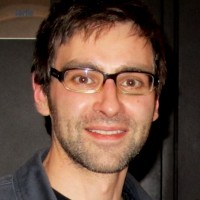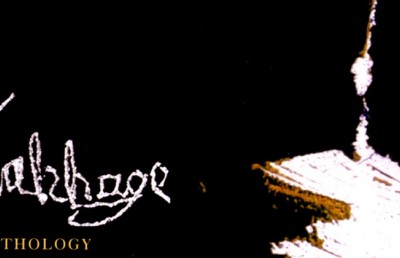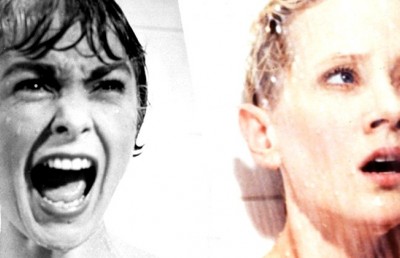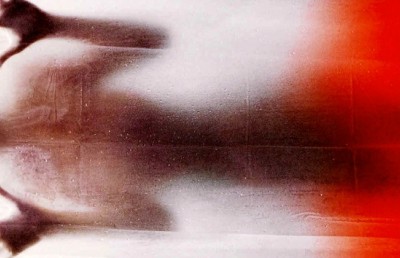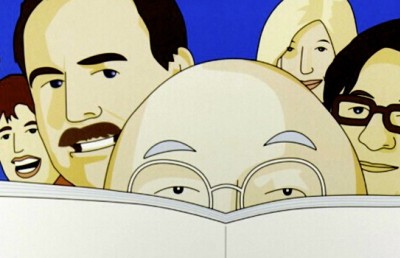The Trail of Werner Herzog: An Interview
Herzog in Montreal
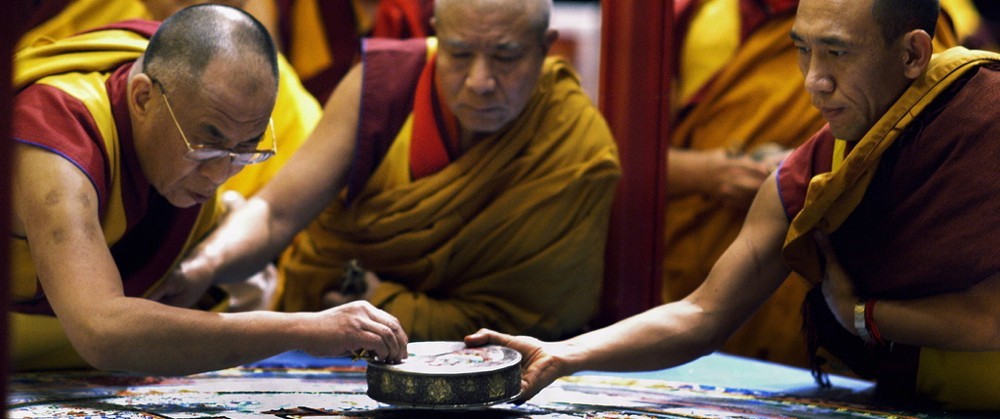
Meeting Werner Herzog was for us not only an occasion to learn more about one of the greatest artists in cinema, but the chance to revisit, with him, images that have remained vividly imprinted in our minds. Herzog is the director of such notable feature films as Aguirre—The Wrath of God, Stroszek, Woyzek, The Enigma of Kaspar Hauser, Fitzcarraldo, etc. But the remarkable unity of his work is further confirmed in his numerous documentaries filmed in the Sahara or on the summit of a volcano, in the United States or in Kuwait. Moreover, one can only truly experience his films when gingerly crossing the thin line between reality and imagination.
Herzog is known for his aversion to both academic discourse and conventional interview questions. But when things turn to the concrete matters of creation and the mysterious power of images, he readily engages in discussion, and with striking lucidity.
Werner Herzog was in Montréal last fall, for the presentation of his latest film Wheel of Time, at the Festival International du Nouveau Cinéma, and for a retrospective of his work at the Cinémathèque québécoise and the Goethe Institute.
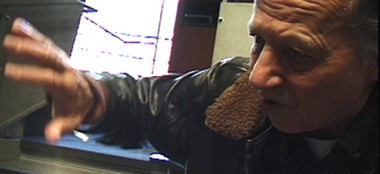
Offscreen: We will begin with a wonderful small book that you wrote in 1974, Of Walking on Ice, the story of your walk from Munich to Paris, which will quickly bring us to your films. The reading of the book is in continuity with the experience of watching your films; it’s as if, through this walk, we witness the process in which images are born. Would it be right to think that in your films, strong images often arise, impose themselves before any specific idea or meaning they should carry?
Offscreen: What makes you so interested in walking? Is it to reach another physical state or mental state?
WH: It is not necessary for me to travel on foot to start out any project. I should explain a bit more precisely. I mean I’m not a backpacker. I’m not someone who jogs or hikes, nor someone who travels on foot all the time, like a time before we had automobiles. I am lazy like everyone else. I walk only for very specific reasons. If there’s something important, yes, I would walk. I walked from Munich to Paris because Doctor Lotte Eisner (historian and critic of German cinema) was dying in Paris.
Offscreen: Coming back to images. In your films there are many images or moments, although sometimes very simple, that stay with us afterwards. We wanted to mention a few. At the end of the documentary Land of Silence and Darkness, the blind, deaf and mute man is walking away and his mother says: “One day I remember he put his hand in the snow and said the word ‘snow’”.
WH: And that was the last word he ever said!
Offscreen: And that still resonates. It seems to say a lot about your work in general and a certain relationship to the world through our senses…
WH: Yes and what follows in particular, when he breaks away from the group he runs into a tree, starts to touch the tree and attempts to figure out it’s branches. That’s the end of the film. When you narrate it like this, it’s a man who is deaf and blind and touching a tree, it is of no consequence, it has no power. But, in a film that works almost one and half-hours towards that image, sensualizes it, all of a sudden it becomes something very very big. And it is mysterious how cinema works in that respect. It is the placement of a shot that makes it so important, and makes it highly significant. It’s like the end of “Stroszek”, for example, with the dancing chicken. But then, the technical crew or almost everyone on location hated the film so much that ultimately the cinematographer refused to shoot it (the shot) and said: “We are going for lunch now if you want to film that shit. “ And I said: “I’m gonna film that shit, sure.” And I tried to tell them. “Don’t you see there’s something very very big here?” And nobody saw it. It was really big. And it’s still one of the best things I ever filmed in my life.
Offscreen: That’s one of the most beautiful endings of a film…
WH: Even the crew that I paid and who were loyal to me went on strike.
Offscreen: Was that scene scripted initially?
WH: I do not remember. I believe it was scripted. Yes! I do believe it was scripted. But I’m not absolutely sure, I should have a look at the screenplay.
Offscreen: And one thing about that scene, it is a rare occurrence of inter-cutting different things happening simultaneously, from Bruno on the mountain to the animals (chickens, ducks, rabbits) dancing and playing music and to the truck on fire making circles outside. Usually your scenes are rather large segments, set in one space, one situation, often shot in long takes….
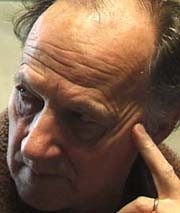
WH: Yes but the animals dance for quite a while so you hang on to that. The problem was that the chickens wouldn’t dance for more than 15 seconds and then they would retreat. We had them in special training for dancing as long as they could. When you fed a quarter into the machine, the music would play and the chicken would dance. And as a reward it would get some corn. They were accustomed to dancing for 3 to 5 seconds. Now I held them in training for a couple of months to dance as long as they could. But they would only dance for 15 seconds. The problem is, I couldn’t get away with an ending that was a 15 second shot. I had quite a few of those shots and I had to add them together. There was always a jump cut. So there were technical reasons behind it as well. Very often it’s not an ideology or so that’s behind something.
Offscreen: Another image, although very short, that has the power to be imprinted in the viewer’s minds, is the sailboat in the tree at the end of Aguirre, the Wrath of God. When he says that he sees the boat, meaning that the sea would be nearby, we assume that Kinski’s character is hallucinating, along with the others on the raft, due to fever. But in the next shot, you show us the sailboat up in the tree, in the middle of the jungle…
WH: You have doubts whether it is true or not. What is your belief? Let’s say also that digital effects did not exist at that time. Nor was there any money for doing much tricks. What is your belief?
Offscreen: My belief was that it wasn’t true, I mean that in reality, inside the film, there is no boat. But you made us share his illusion, his hallucination, while in the rest of the film, we see from ‘outside’ the journey and the madness, it is never a question of getting into a character’s mind.
WH: Yes, that’s good to say. What is your opinion?
Offscreen: I think what is interesting is in the probability, whether it’s true or not, that there is a boat in that tree. You filmed it. The sheer presence of it makes it very powerful. The fact of it being in the story is enough for me.
WH: All right. Well, all I can say is that we did build it. We had something like 15 to 18 people working on it. They built a scaffold around a huge tree and bit by bit they put a boat together. But of course it would not be able to float because it had no real bottom. And it had no real other side. But it had a mast, it had a canoe dangling from it’s stern. And it had sails and quite everything massively built, because out there in the jungle you can’t get hold of, let’s say, papier mache or plastic. You just hire a few local people and they start to build it.
Offscreen: Did that idea come along while shooting?
WH: I only remember that the end of the film was totally different. The end was actually the raft going out into the open ocean and being swept back inland, because for many miles you have a counter-current, the Amazon actually goes backwards. And it was tossed to and fro. And a parrot would scream: “El Dorado, El Dorado”, as far as I can remember.
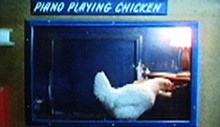
Offscreen: Talking about things you can bring to a script, did you suggest certain things to Harmony Korine when you played the father in Julian Donkey Boy? Like the parrot story, when you are getting your hair cut…
WH: I always had to invent it. I don’t remember what was said because there was never any dialogue. That story… Oh yeah! Now I remember. It’s a parakeet, the World Champion Talking Bird who said very clearly: “Birds are very smart, but they can’t speak!” There was never any dialogue. He sat me at a table with my family, I mean, “family.” And I knew I had to be dysfunctional and wild and primal and terrifying with them. And I turn around and I see that the cameras are rolling and I say: “Are we rolling?” and he nods to me and I say: “What’s the scene all about?” and he just shrugs. And I say: “What’s the dialogue?” and he just said to me: “Speak”. So what can you do? I just had to do some dialogue.
Offscreen: And there it was the Clint Eastwood story…
WH: Yes. All of that was just born out of the pressure of having to speak and having to say something.
Offscreen: Another image, one of the most powerful in your work, one that left a lasting impression is in Stroszek. Bruno, beaten, depressed, goes to see a doctor who brings him to the nursery. The doctor lifts up a newborn baby and allows it to hang from his fingers. He shows Bruno the strength of the baby who can already hold on with all its weight. It is very important in regards to Bruno’s character (and himself), but I think it also relates to other figures in your films, like Fini Straubinger, Fitzcarraldo, Steiner…
WH: A prematurely born baby! And the strength…
Offscreen: Yes the strength. This seems to be very important for many of your characters, they hang on, and they keep going…
WH: Yes, that image is very beautiful, I know. But I can’t really explain it because it doesn’t have much to do with the story. It wouldn’t change the story at all if you took it out. Sometimes, it’s blind motives that captivate us more than anything else. I don’t know how they come to me, but I know it’s big. I know it’s something very big….
Offscreen: When you look back on your work, do you think it functions more as a series of strong illuminating moments than as an ongoing exploration of themes, narratives…?
WH: No, I am a storyteller. These moments would not exist without everything that leads to it. If you show the last sequence of Land of Silence and Darkness to anyone, it does not make any impact at all. It’s a very average image. A man stands up from a bench and walks towards a tree. You notice that he must be blind because he bumps into some branches and starts to touch the stem, the trunk… That’s all there is, nothing more. Only in context, after spending nearly 90 minutes in the world of blind and deaf people, with the knowledge preparing your heart, your mind and your spirituality for something extraordinary, which is in the image, only then will you be able to see it.
Offscreen: So would the image of the baby in Stroszek be an exception in that matter? Something that really stands on it’s own, that is self-sufficient in its power and beauty regardless of the story?
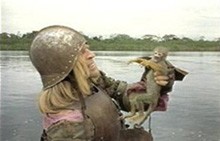
WH: No it is not. It is also only because of the tremendous suffering of Stroszek, the torment of his soul…Only having seen that and following that, only then and in context, does the shot become extraordinary. These moments do not exist per se.
Offscreen: What are you searching for when you shoot a documentary like The Land of Silence and Darkness?
WH: ‘Land of…’ without ‘The’, but here the French they do it wrong, they say, “Le pays…” it’s wrong it should be “Pays…”, Land of Silence and Darkness without the article. The article takes the beauty away from the title.
Offscreen: Yes, indeed. So in such a film, which culminates in a way with the last scene, where the film finds its full meaning, do you look for that? Do you find it and know that you have something while you’re shooting it? Or is it for instance while editing that you see the structure take shape?
WH: Yes it culminates with that man, whom we talked about, who lived in the stable with the cattle, to find some sort of warmth. When you make films, you sense it very quickly in which order you have to narrate a story like that. And there was not very much footage. Much of it was shot 1 to 1. And the whole film is made with about half of the footage that was shot.
Offscreen: We often return to the documentary film Land of Silence and Darkness because it seems, whether you were aware of it or not, that in making it, you found many things that would later occupy your work.
WH: Yes. It’s one of the essential things I’ve done. I know that.
Offscreen: You have often been associated with New German Cinema…
WH: Which is a fiction anyway. Please continue.
Offscreen: Let’s say all the filmmakers of your generation, whether you feel affiliated with them or not, all dealt in some way or another with Germany, with the present or the past. Did you feel very early that you needed to go away in terms of the subject, locations and context? ‘Germany’s past’ as a subject hasn’t really interested you until Invincible?
WH: Yes.
Offscreen: Is there a reason for that?
WH: I don’t know. Sure, when you look at the others they did different subjects. But when we look at my films, I think it is obvious that I never left my culture. And I think that’s more decisive.
Offscreen: What about your look at the present world, given the fact that in many of your feature films, the story is set in the past?
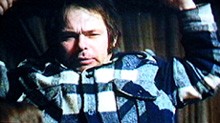
WH: A few films are in the past, like Kasper Hauser, Aguirre, Fitzcarraldo…. But it doesn’t mean to leave the present either. When you look at Shakespeare, I really do not want to compare myself, but when Shakespeare wrote Hamlet, which was a story about a Danish prince, hundreds of years before his time, he didn’t leave his time anyway. Or in writing Richard the III, he didn’t leave his time, even though this story is dating back hundred’s of years.
Offscreen: So are the films set in the past allegorical in their relation to the present?
WH: No. Allegorical? No I don’t understand that. I don’t have any sensory organs for that. I can only point to Shakespeare; do you think that he somehow was rooted in the past? And could only look backwards because he wrote Hamlet?
Offscreen: Concerning walking again, you often talk about the virtue of walking. Yesterday at the press conference, you said that walking is the best way to discover a landscape. But you also said that when you shoot a film you don’t have time to walk, being too caught up in the production. Still, one could say that when we watch your films, we have the sensation of being taken for a walk, it’s in the films’ pace and feeling…
WH: Sure, but it’s not necessarily tied to what happens in the production. It’s always something different when you just watch a film on the screen. Concerning the process behind the making, it doesn’t help to know anything about it. The making of the film requires a lot of discipline and a lot of performance ad hoc, where you have to deliver no matter what. The procedure is sometimes very banal, very stupid, very technical and is filled with discipline. It’s a struggle with banalities in order to save something that stays in your heart and in your soul for a long time. It helps not to know the process. But since you know about filmmaking and since you are asking these questions, you must know that cinema works that way, the making of cinema works that way.
Offscreen: You have to fight against banalities?
WH: You cannot avoid them because they are persuasive. And bureaucracy is one of the all-persuasive enemies. You have to be endowed with enough perseverance and enough philosophy and enough street smartness to handle it anyway.
Offscreen: There is something about temporality in your films, at times scenes are repetitive, like the plane landing over and over again in Fata Morgana. And sometimes there is also a kind of dilated time, perhaps again something akin to the state of perception we can reach when walking for a long time?
WH: Let’s stick to filmmaking even though the background of your question is interesting. Yes, sure there is a certain rhythm that comes, through one’s existence and by travelling on foot once and a while. It’s a question of rhythm and that is not established during editing. We establish rhythm while we are shooting. It’s a myth when filmmakers tell you: “I put the rhythm in the editing”. It doesn’t work like that. It is about some sense of timing and musicality. As an example, in terms of musicality, sometimes a shot has to be very long, out of proportion. Very early in the beginning of Aguirre there is a shot of the ferocious river, boiling. You see it for a long time. Seeing it for three seconds would be enough to know it is an angry boiling river. But I believe you see it for thirty seconds or so. It is completely out of proportion. But having seen that so early in the film, you accept more easily as an audience all of the disproportion to come, the disproportion of a character, the disproportionate fever, the disproportion of losing orientation, the disproportion of grandiose designs of conquering the continent with 30 starving men. It prepares the field. You plough the fields very carefully to sow and then you harvest.
Offscreen: At the press conference you said that you wanted the viewers “to be able to trust their eyes again”. In the film Invincible, for the actress to be credible when she wakes up from hypnosis, you said that you actually taught Tim Roth how to hypnotize. In another instance, Jouko Ahola who plays the Jewish strong man, was truly lifting 800 pounds, which he could only perform once. We could also think of Fitzcarraldo, where you did in reality, take the boat up the mountain and later threw it down into the rapids. Are there other moments when that wish of yours for the viewers “to trust their eyes” defined how you were going to do something with no tricks?
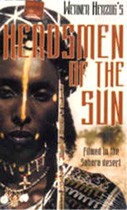
WH: Sure, in many of my films. But we can extend the meaning of that. In The Great Ecstasy of Woodcarver Steiner, a man is flying, let’s face it. And there is no one who defies gravity like him with maybe the exception of Fitzcarraldo!
Offscreen: The Great Ecstasy… is your documentary about a ski-jumping champion. On that subject, I find very intriguing the other image of a ski-jumper, that one being in Land of Silence and Darkness. Fini Straubinger, now blind and deaf, says that something that she remembers from her childhood was watching men fly in the air at a ski-jumping competition. You inserted an image of a man flying with his skis against the sky. But that was two years before you made The Great Ecstasy…?
WH: That was made up. It was all made up. I gave her that sentence to speak for me. And she understood.
Offscreen: So it was actually you being inhabited by that image?
WH: It is how I would somehow reach a very very deep truth about her. That is exactly what I call “ecstatic truth”, which is at the centre of my work. Very early on, I had the feeling that only through invention and stylization would I reach a very deep truth about a character, even in a documentary. So in this case it is made up. But as much as it is made up, it also points to her deepest truth
Transcribed and edited by Nancy Barić. Published in a French translation on Hors Champ, and translated from French by Nicolas Renaud.
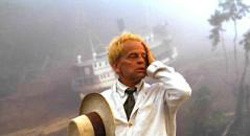
Within the special film programmes organised by Hors Champ at the Cinémathèque québécoise since 2001, we have presented the Herzog documentaires Woodaabe: Herdsmen of the Sun and Land of Silence and Darkness.
* Hors Champ would like to thank Adrien Gonzalez of the FCMM for helping to make this interview possible.

